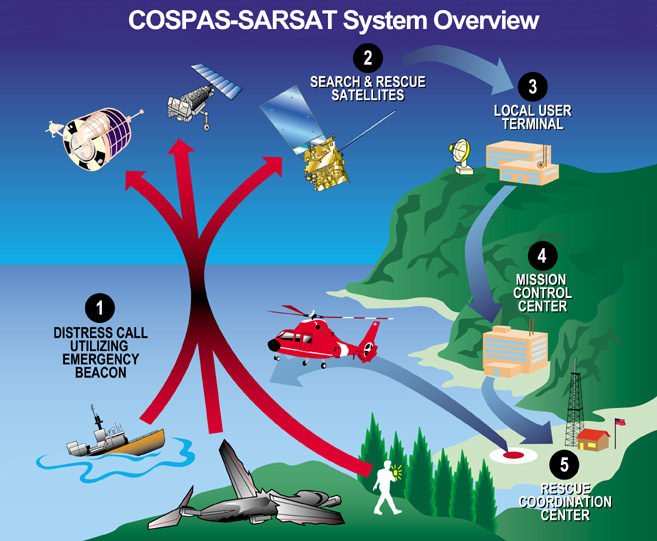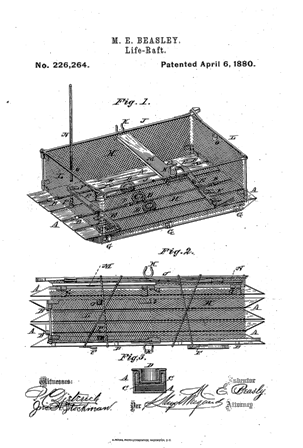|
Liferaft
A lifeboat or liferaft is a small, rigid or inflatable boat carried for emergency evacuation in the event of a disaster aboard a ship. Lifeboat drills are required by law on larger commercial ships. Rafts (liferafts) are also used. In the military, a lifeboat may double as a whaleboat, dinghy, or gig. The ship's tenders of cruise ships often double as lifeboats. Recreational sailors usually carry inflatable liferafts, though a few prefer small proactive lifeboats that are harder to sink and can be sailed to safety. Inflatable lifeboats may be equipped with auto-inflation (carbon dioxide or nitrogen) canisters or mechanical pumps. A quick release and pressure release mechanism is fitted on ships so that the canister or pump automatically inflates the lifeboat, and the lifeboat breaks free of the sinking vessel. Commercial aircraft are also required to carry auto-inflating liferafts in case of an emergency water landing; offshore oil platforms also have liferafts. Ship-launche ... [...More Info...] [...Related Items...] OR: [Wikipedia] [Google] [Baidu] |
Davit
Boat suspended from radial davits; the boat is mechanically lowered Gravity multi-pivot on Scandinavia'' file:Bossoir a gravité.jpg, Gravity Roller Davit file:Davits-starbrd.png, Gravity multi-pivot davit holding rescue vessel on North Sea ferry file:Freefall lifeboat.JPG, Freefall lifeboat on the ''Spring Aeolian'' file:Frapping line.jpg, Frapping line Labeled Tricing Gripe Steps to launch davit Roller Gravity Davit A davit (pronounced "dayvit" or see Wiktionary) is any of various crane-like devices used on a ship for supporting, raising, and lowering equipment such as boats and anchors. Davit systems are most often used to lower an emergency lifeboat to the embarkation level to be boarded. The lifeboat davit has falls (now made of wire, historically of manila rope) that are used to lower the lifeboat into the water. Davits can also be used as man-overboard safety devices to retrieve personnel from the water. The maintaining and operation of davits is all under jurisdi ... [...More Info...] [...Related Items...] OR: [Wikipedia] [Google] [Baidu] |
Emergency Position-Indicating Radio Beacon
An Emergency Position-Indicating Radio Beacon (EPIRB) is a type of emergency locator beacon for commercial and recreational boats, a portable, battery-powered radio transmitter used in emergencies to locate boaters in distress and in need of immediate rescue. In the event of an emergency, such as a ship sinking or medical emergency onboard, the transmitter is activated and begins transmitting a continuous 406 MHz distress radio signal, which is used by search-and-rescue teams to quickly locate the emergency and render aid. The signal is detected by satellites operated by an international consortium of rescue services, COSPAS-SARSAT, which can detect emergency beacons anywhere on Earth transmitting on the distress frequency of 406 MHz. The satellites calculate the position or utilize the GPS coordinates of the beacon and quickly passes the information to the appropriate local first responder organization, which performs the search and rescue. As Search and Rescue approach the ... [...More Info...] [...Related Items...] OR: [Wikipedia] [Google] [Baidu] |
Titanic Lifeboat
RMS ''Titanic'' was a British passenger liner, operated by the White Star Line, which sank in the North Atlantic Ocean on 15 April 1912 after striking an iceberg during her maiden voyage from Southampton, England, to New York City, United States. Of the estimated 2,224 passengers and crew aboard, more than 1,500 died, making it the deadliest sinking of a single ship up to that time. It remains the deadliest peacetime sinking of a superliner or cruise ship. The disaster drew public attention, provided foundational material for the disaster film genre, and has inspired many artistic works. RMS ''Titanic'' was the largest ship afloat at the time she entered service and the second of three s operated by the White Star Line. She was built by the Harland and Wolff shipyard in Belfast. Thomas Andrews, the chief naval architect of the shipyard, died in the disaster. ''Titanic'' was under the command of Captain Edward Smith, who went down with the ship. The ocean line ... [...More Info...] [...Related Items...] OR: [Wikipedia] [Google] [Baidu] |
Lifeboats Of The RMS Titanic
The lifeboats of the RMS ''Titanic'' played a crucial role in the disaster of 14–15 April 1912. The ship had 20 lifeboats that, in total, could accommodate 1,178 people, little over half of the 2,223 on board the night it sank. had a maximum capacity of 3,547 passengers and crew. Eighteen lifeboats were used, loading between 11:45 p.m. and 2:05 a.m., though Collapsible Boat A floated off the ship's partially submerged deck, and Collapsible Boat B floated away upside down minutes before the ship upended and sank. Many lifeboats only carried half of their maximum capacity; there are many versions as to the reasoning behind half-filled lifeboats. Some sources claimed they were afraid of the lifeboat buckling under the weight, others suggested it was because the crew were following orders to evacuate women and children first. As the half-filled boats rowed away from the ship, they were too far for other passengers to reach, and most lifeboats did not return to th ... [...More Info...] [...Related Items...] OR: [Wikipedia] [Google] [Baidu] |
United Kingdom
The United Kingdom of Great Britain and Northern Ireland, commonly known as the United Kingdom (UK) or Britain, is a country in Europe, off the north-western coast of the continental mainland. It comprises England, Scotland, Wales and Northern Ireland. The United Kingdom includes the island of Great Britain, the north-eastern part of the island of Ireland, and many smaller islands within the British Isles. Northern Ireland shares a land border with the Republic of Ireland; otherwise, the United Kingdom is surrounded by the Atlantic Ocean, the North Sea, the English Channel, the Celtic Sea and the Irish Sea. The total area of the United Kingdom is , with an estimated 2020 population of more than 67 million people. The United Kingdom has evolved from a series of annexations, unions and separations of constituent countries over several hundred years. The Treaty of Union between the Kingdom of England (which included Wales, annexed in 1542) and the Kingdom of Scotland in 170 ... [...More Info...] [...Related Items...] OR: [Wikipedia] [Google] [Baidu] |
Maria Beasley
Maria E. Beasley (''née'' Hauser; 1836–1913) was an American entrepreneur and inventor. Born in North Carolina, Beasley grew up with a strong interest in mechanical work and learned about the profession of barrel-making from her grandfather. Between 1878 and 1898, she patented fifteen inventions in the United States: these included a footwarmer, an improved life raft, and an anti-derailment device for trains; however, her primary success as an inventor rose from a specialty in barrel-making machines and processes. Beasley licensed a patent to the Standard Oil Company, exhibited her work at the World's Industrial and Cotton Centennial Exposition and the World's Columbian Exposition, and founded two companies for the design and manufacture of barrels (one of which later sold for $1.4 million, the ). Early life Maria Hauser was born in 1836 in North Carolina to a wealthy family. Her parents were Anna Johanna Spach and Christian Hauser, and Christian was a miller. Maria showed ... [...More Info...] [...Related Items...] OR: [Wikipedia] [Google] [Baidu] |
Board Of Trade
The Board of Trade is a British government body concerned with commerce and industry, currently within the Department for International Trade. Its full title is The Lords of the Committee of the Privy Council appointed for the consideration of all matters relating to Trade and Foreign Plantations, but is commonly known as the Board of Trade, and formerly known as the Lords of Trade and Plantations or Lords of Trade, and it has been a committee of the Privy Council of the United Kingdom. The board has gone through several evolutions, beginning with extensive involvement in colonial matters in the 17th century, to powerful regulatory functions in the Victorian Era and early 20th century. It was virtually dormant in the last third of 20th century. In 2017, it was revitalised as an advisory board headed by the International Trade Secretary who has nominally held the title of President of the Board of Trade, and who at present is the only privy counsellor of the board, the other m ... [...More Info...] [...Related Items...] OR: [Wikipedia] [Google] [Baidu] |
George Shaw-Lefevre, 1st Baron Eversley
George John Shaw Lefevre, 1st Baron Eversley (12 June 1831 – 19 April 1928) was a British Liberal Party politician. In a ministerial career that spanned thirty years, he was twice First Commissioner of Works and also served as Postmaster General and President of the Local Government Board. Background and education George Shaw Lefevre was the only son of Sir John Shaw Lefevre and Rachel Emily, daughter of Ichabod Wright. He was born in Battersea, and was the nephew of Charles Shaw-Lefevre, 1st Viscount Eversley, Speaker of the House of Commons. He was educated at Eton and at Trinity College, Cambridge, and was called to the Bar, Inner Temple, in 1855. Political career Shaw Lefevre stood unsuccessfully as the Liberal candidate for Winchester in 1859 but was successfully returned for Reading in 1863, a seat he held until 1885. his maiden speech in the House of Commons was made on the ''Alabama'' incident, and in 1868 he was instrumental in calling for arbitration of the Ala ... [...More Info...] [...Related Items...] OR: [Wikipedia] [Google] [Baidu] |
House Of Commons Of The United Kingdom
The House of Commons is the lower house of the Parliament of the United Kingdom. Like the upper house, the House of Lords, it meets in the Palace of Westminster in London, England. The House of Commons is an elected body consisting of 650 members known as members of Parliament (MPs). MPs are elected to represent constituencies by the first-past-the-post system and hold their seats until Parliament is dissolved. The House of Commons of England started to evolve in the 13th and 14th centuries. In 1707 it became the House of Commons of Great Britain after the political union with Scotland, and from 1800 it also became the House of Commons for Ireland after the political union of Great Britain and Ireland. In 1922, the body became the House of Commons of the United Kingdom of Great Britain and Northern Ireland after the independence of the Irish Free State. Under the Parliament Acts 1911 and 1949, the Lords' power to reject legislation was reduced to a delaying power. The g ... [...More Info...] [...Related Items...] OR: [Wikipedia] [Google] [Baidu] |






